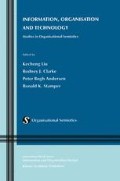Abstract
Software agent technology is an important advance in the management of information systems that has brought even more potential to the improvement of efficiency and effectiveness of business systems. Timely access to the right information at the shortest time is important in many of our personal and business activities. Agents are also increasingly needed for interoperation between different applications in business processes. Many researchers have emphasised on mental agency, which is the supposition that software agents should be understood primarily in terms of mental concepts and behaviours such as beliefs and intentions (Singh 1998; Chong and Liu 1999). Software agents are widely seen as a personal helper to human users in the tasks of information management, information processing, information routing, amongst many other tasks. For software agents to provide valuable services, several characteristics must exist. One of these characteristics is that human users delegate its job functions.
Access this chapter
Tax calculation will be finalised at checkout
Purchases are for personal use only
Preview
Unable to display preview. Download preview PDF.
References
Aylett, R., Brazier, F., Jennings, N., Luck, M., Nwana, H. and Preist, C. (1998) “Agent Systems and Applications”, The Knowledge Engineering Review, 13 (3), pp. 303–308
Chong, S. and Liu, K. (1999) “A Semiotic Approach to the Design of Agent-mediated E-Commerce Systems”, Proceedings of IFIP WG 8.I International Working Conference ISCO-4, pp. 95–114
Collis, J.C. and Lee, L.C. (1998) “Building Electronic Marketplaces with the ZEUS Agent Toolkit”, Proceedings of the Agent-Mediated Electronic Trading (AMET) Workshop, May, pp. 17–32
Collis, J.C., Ndumu, D.T., Nwana, H.S. and Lee, L.C. (1998) “The ZEUS Agent Building Toolkit” BT Technology Journal, 16(3), pp. 60–68
Conte, R. and Castelfranchi, C. (1995) “Cognitive and Social Action”, UCL Press Limited
Eichmann, D. (1994) Ethical Web Agents, Proceedings of the Second World Wide Web Conference’94: Mosaic and the Web, Chicago, Illinois, USA, October 17–20.
Etzioni, O. and D. Weld (1994) A Softbot-Based Interface to the Internet, Communications of the ACM, 37 (7), pp. 72–76.
Dennett, D.C. (1987) “The Intentional Stance”, MIT Press
Gruber, T. A. (1991) “Ontolingua: A Mechanism to Support Portable Ontologies”, KSL-99-66, Stanford University Knowledge Systems Laboratory
Liu, K. (2000) “Semiotics in Information Systems Development”, Cambridge University Press
Liu, K. and Dix, A. (1997) “Norm Governed Agents in CSCW”, 1 st International Workshop on Computational Semiotics, University of De Vince, Paris
Liu, K., Alderson, A., Shah, H., Sharp, B. and Dix, A. (1998) “Applying Semiotic Methods to Requirements Recovery”, Proceedings of the BCS 6 th International Conference on Information Systems Methodologies, University of Salford, Salford
Moses, Y. and Tennenholtz, M. (1992) “On Computational Aspects of Artificial Social Systems”, Technical Report CS91-01, Weizmann Institute
Norman, D. (1994) How Might People Interact with Agents? Communications of the ACM, 37 (7), pp. 68–76.
Nwana, H. and Wooldridge, M. (1996) “Software Agent Technologies”, BT Technology Journal, 14(4), pp. 68–78
Rao, A.S. (1995) “Decision Procedures for Propositional Linear-Time Belief-Desire-Intention Logics”, in Wooldridge, M. Muller, J.P. and Tambe, M. (Eds.), Intelligent Agents II, Springer
Ross, A. (1968) “Directives and Norms”, Routledge and Kegan Paul
Shoham, Y. (1997) “An Overview of Agent-Oriented Programming”, in Bradshaw, J.M. (Ed) Software Agents, AAAI Press, pp. 271–290
Shoham, Y. and Tennenholtz, M. (1992) “On the Synthesis of Useful Social Laws in Artificial Societies”, Proceedings of the 10 th National Conference on Artificial Intelligence, Kaufmann, pp. 276–282
Singh, M.P. (1994) “A Theoretical Framework for Intentions”, Know-How, and Communication, Berlin: Springer-Verlag
Singh, M. P. (1998) “Agent Communication Language: Rethinking the Principles”, Computer: Innovative Technology for Computer Professionals, December, pp. 40–47
Stamper, R. (1973) “Information in Business and Administrative Systems”, 2nd edition, Basil Blackwell, Oxford
Stamper, R. (1980) “LEGOL: Modelling Legal Rules by Computer”, in Niblett, B. (Ed.), Computer Science and Law, Cambridge University Press, Cambridge
Stamper, R. (1998) “Extending Semiotics for the Study of Organisations” Proceedings of Semiotics and the Information Sciences, University of Toronto
Stamper, R. and Liu, K. (1994) “Organisational Dynamics, Social Norms and Information Systems”, Proceedings of the 27 th Hawaii International Conference on System Sciences, pp. IV645–654, Hawaii
Stamper, R., Liu, K., Hafkamp, M. and Ades, Y. (2000) “Understanding the Role of Signs and Norms in Organisations — A Semiotic Approach to Information Systems Design”, Behaviour and Information Technology (To appear)
Ullman-Margalit, E. (1977) “The Emergence of Norms”, Clarendon Press, Oxford
Wooldridge, M. and Jennings, N.R. (1995) “Intelligent Agents: Theory and Practice” The Knowledge Engineering Review, 10(2), pp. 115–152
Editor information
Editors and Affiliations
Rights and permissions
Copyright information
© 2001 Springer Science+Business Media New York
About this chapter
Cite this chapter
Chong, S., Liu, K. (2001). A Semiotic Approach for Distinguishing Responsibilities in Agent-Based Systems. In: Liu, K., Clarke, R.J., Andersen, P.B., Stamper, R.K. (eds) Information, Organisation and Technology. Information and Organisation Design Series, vol 1. Springer, Boston, MA. https://doi.org/10.1007/978-1-4615-1655-2_6
Download citation
DOI: https://doi.org/10.1007/978-1-4615-1655-2_6
Publisher Name: Springer, Boston, MA
Print ISBN: 978-1-4613-5662-2
Online ISBN: 978-1-4615-1655-2
eBook Packages: Springer Book Archive

